Britain has an illustrious history of cartoonists and illustrators who have been ready to represent life and all its ugliness in spectacularly ugly fashion. Hogarth’s work still has the power to repel, and in Georgian Britain, caricaturist James Gillray made things even more grotesque, regularly representing the monarchy for whom the era was named as toothless, gormless idiots, whilst turning ideals – such as the French Revolution – into allegorical depictions of monsters. If Gillray was the man best-known for sending up the Regency, then it was George Cruikshank who best satirised the rest of the 19th Century – initially following in his father Isaac’s illustrious footsteps as his apprentice. In the earliest years of his career, Cruikshank turned his own hand to political satire; then, as now, there was ample material, and to be fair, the Prince Regent often made himself a ripe target for ridicule…
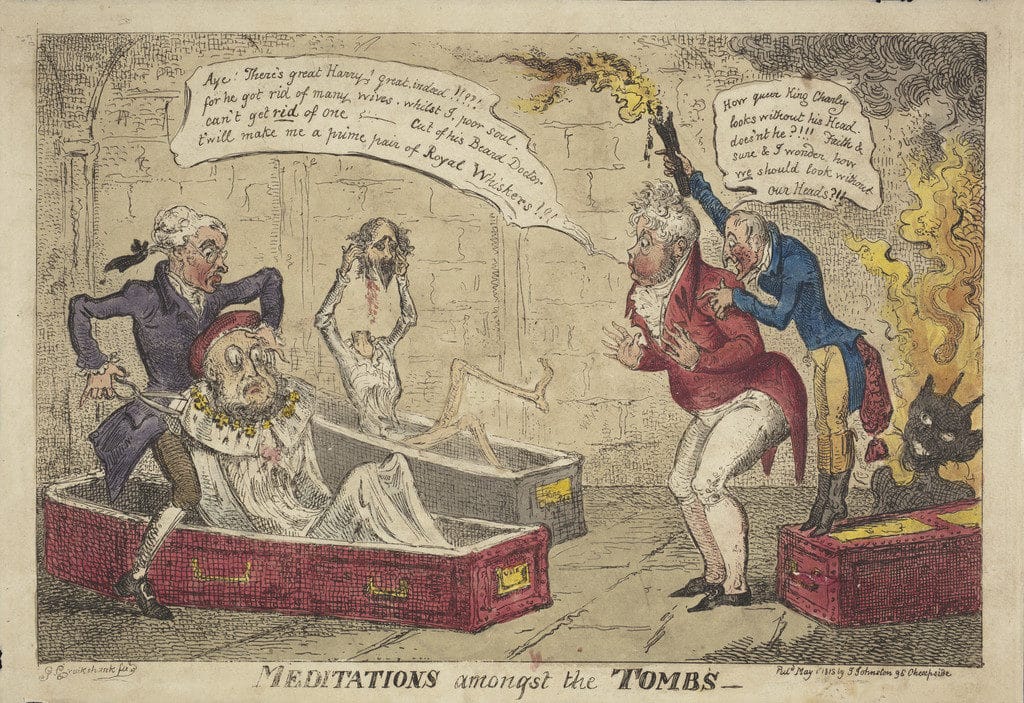
In Meditations Amongst The Tombs (1813), Cruikshank used a curious story which had begun to circulate about the Regent’s orders for the construction of a new burial vault at Windsor Castle. As the vault was being dug, his men found the tombs of Henry VIII and Charles I and, in the interests of science, the Regent ordered an autopsy be performed on King Charles. You could rank that as one of the most unnecessary autopsies ever performed, I’d say, but nonetheless, the Regent gave instructions to the royal physician to do the deed. Cruikshank has some fun with this. The image shows the headless Charles I sitting up in dismay as the royal physician himself sits astride the corpse of King Henry (or ‘Harry’, as the Regent is calling him). The doctor is preparing to cut some of Henry’s beard away for the purposes of making some ‘royal whiskers’. Meanwhile, the Regent, who bemoans the fact that Henry had got rid of so many wives when he couldn’t even shift one, doesn’t notice the grinning devil sitting behind him. Even now, you could wonder whether a modern cartoonist would avoid depicting the monarch as a tomb raider, but Cruikshank couldn’t resist, it seems. His satires were clearly effective: in 1820, the Regent bribed Cruikshank £100 – around £5,000 or more in today’s money – to stop putting him in his cartoons. Cruikshank took the money, and moved on to other things, though not without a bit more grave-robbing in art later in his career.
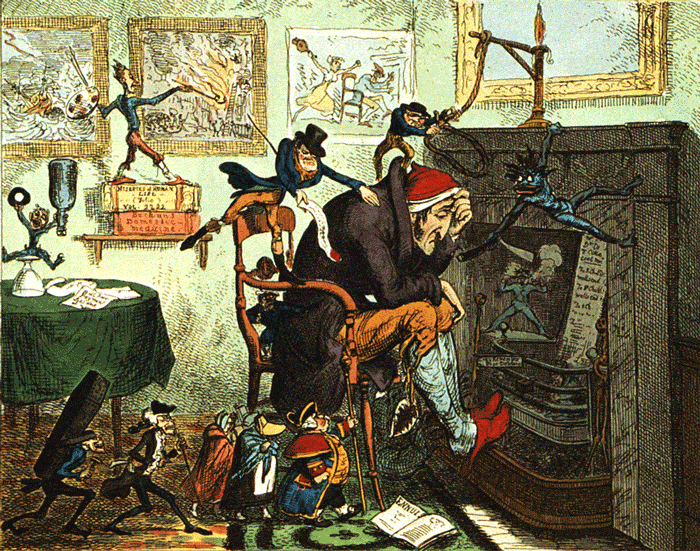
Cruikshank seemed to enjoy drawing and engraving supernatural subjects, and he included demons in his illustrations with the enthusiasm of all those medieval artists who seemed to relish an excuse to put their imaginations to mischievous use. In The Blue Devils! (1823) however, the imps at play in the picture are joining forces with contemporary evils to torment a man with what would then have likely been called melancholy – and today would probably be described as depression or anxiety. A gloomy figure sits at an extinguished fire, as a troupe of tiny debt-collectors, aldermen and other figures assault him. He does not acknowledge their efforts, but the artwork on the walls and the titles in his library – ‘Miseries of Human Life’ and ‘Ennui’ – speak to his mental state. Alongside his modern concerns, dance the more conventional demons: look at the creature leering delightedly beneath his chair.
Whilst this is not the straightforward anti-alcohol art to which Cruikshank would later dedicate so much effort, one of the creatures here is nonetheless holding an upended bottle. Perhaps at the time this engraving was made, Cruikshank was still himself drinking, but in any case, this is a striking portrayal of a man’s unhappy state – whether Cruikshank’s own, or man in general. In this era, there was probably much to be unhappy and anxious about. Many of those problems we still share today, but some we do not.
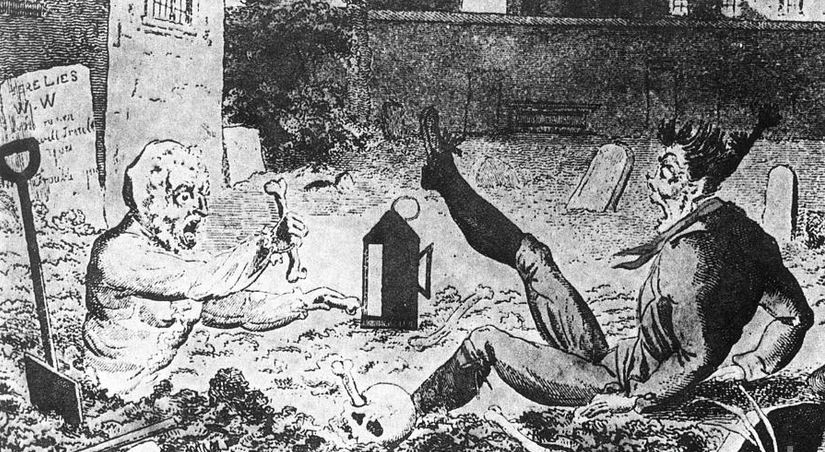
His 1830 engraving Ghost and Grave Robber deals with a real preoccupation of the era – the Resurrection Men, those who would sneak into graveyards and remove dead bodies for the purposes of sale to medical professionals who couldn’t get enough subjects for their work. It was risky, lucrative – and naturally reviled by a wary population. In this engraving, Cruikshank recycles some of the attitudes and themes of his earlier satire. The Resurrectionist’s tools of the trade – lantern, shovel and pick – are scattered around, but he has been interrupted and terrified by the appearance of a ghost. Well, when we say ghost, do we mean reanimated corpse? The creature responsible seems about as corporeal as they come, wearing burial garb and brandishing a human bone at his assailant. In any case, it’s an arresting image and perhaps offers some schadenfreude for a general population who had been swept into paranoia by the prospect of being hauled out of their graves by the neck and sold like a cut of meat.
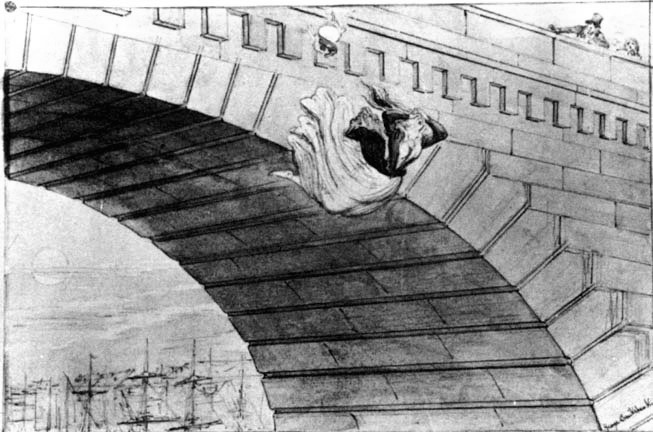
In the following years, Cruikshank’s career saw him dividing his time across a great number of disparate projects, but perhaps most famously he worked alongside Charles Dickens as an illustrator. The two men collaborated for years, and Cruikshank provided the artwork for some of Dickens’s most famous novels, such as Oliver Twist, which included a grim depiction of Fagin in the condemned cell, waiting for his hanging to take place at dawn. However, the two men did part ways: there are many reasons this could have happened, but it has been suggested that Cruikshank’s increasing antipathy to the demon drink may have been a factor. Cruikshank was soon to throw in his lot with the Temperance Movement, a social movement which believed in the complete prohibition of alcohol, whereas Dickens believed moderation was possible. Cruikshank’s stance is understandable: his father and brother were alcoholics, his father died after taking part in a drinking competition and Cruikshank himself went through a period of heavy drinking – facts which are unlikely to endear you to the substance. Within ten years of Oliver Twist, Cruikshank had released a series of engravings under the title of The Bottle, a Hogarth-style series showing a family decimated by addiction. Cruikshank hammered at this topic repeatedly through the course of his career; certainly, alcohol was (and is, let’s be fair) a destructive force in his society and it wreaked additional havoc where there was no reliable health provision and rampant malnutrition generally. After The Bottle, Cruikshank designed a 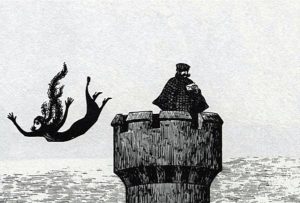 series called The Drunkard’s Children – again, focusing on the innocent victims of the sins of the parents. The detail from The Drunkard’s Children shown here – the title of which I’ve shortened to ‘Gin Mad’ (1848) – is quite a rarity for showing the moment of a suicide, something which was a heinous crime and a sin. This is not a particularly poetic depiction of a death, either. The girl falls, her back arched, her face terrified, with her bonnet streaming behind her as she crashes towards the cold Thames below. It’s an arresting image that Cruikshank would certainly have intended to frighten people, and possibly it did. This contorted stance crops up again in a more modern work, which could attest to its influence on other artists: look at this drawing in The Object Lesson by Edward Gorey.
series called The Drunkard’s Children – again, focusing on the innocent victims of the sins of the parents. The detail from The Drunkard’s Children shown here – the title of which I’ve shortened to ‘Gin Mad’ (1848) – is quite a rarity for showing the moment of a suicide, something which was a heinous crime and a sin. This is not a particularly poetic depiction of a death, either. The girl falls, her back arched, her face terrified, with her bonnet streaming behind her as she crashes towards the cold Thames below. It’s an arresting image that Cruikshank would certainly have intended to frighten people, and possibly it did. This contorted stance crops up again in a more modern work, which could attest to its influence on other artists: look at this drawing in The Object Lesson by Edward Gorey.
Even more anti-alcohol illustration was to come. Was Cruikshank simply possessed by this topic? The Worship of Bacchus (1867), one of his last great works, displays a sprawling, sepia-tinged landscape, a combination of engraving and oils which looks quite unlike many of his earlier pieces. It was a last-ditch attempt to encapsulate the ‘cradle to grave’ idea which Cruikshank believed in, and an unashamed propaganda piece, where people go from functional to feckless. Cruikshank, by then a querulous old man, toured the huge picture around the country in an effort to persuade people of his message. In fact, something about the painting reminds me of Bruegel’s ‘Triumph of Death’ of three hundred years prior, although the skyline of the later painting is festooned with the trappings of Victorian Britain – the ragged schools, the hospital, the factories. Cruikshank laboured for years over the preparation for this one, and clearly had high hopes for it, though of course we have no idea of its efficacy and we know people continued to drown their sorrows, as ever.

Rambunctious, ambitious and moralising by turns, Cruikshank seems to neatly embody the century in which he made his name. His good humour was expansive, and his work was meticulous, although he certainly obsessed with the idea of sobriety with all the zealousness of a convert, ditching much of the variety his work had formerly contained. The work he did on the dangers of drink was in its way just as interesting, though, and he clearly felt very passionately about the cause, committing himself to using his artistic skills to further his beliefs. This was his prerogative, and it’s hard to dispute his earnestness. He carried this earnestness with him to the grave, where his marker (in Kensal Green Cemetery, London) declares his abstinence with pride.
Interestingly, however, upon his death, a surfeit of wine was found to be in Cruikshank’s possession. Was he still a drinker after all? Did he harbour some alcohol to dispel the panic of the alcoholic when they find themselves left without a dram? Was it a hair shirt for him? Or was the wine simply a costly item which deserved its place in his will? We don’t know, of course, but it’s certainly true that sometimes a person best satirises or rails against what they know the best.